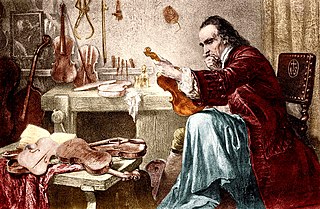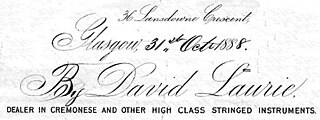Related Research Articles

Antonio Stradivari was an Italian luthier and a craftsman of string instruments such as violins, cellos, guitars, violas and harps. The Latinized form of his surname, Stradivarius, as well as the colloquial Strad are terms often used to refer to his instruments. It is estimated that Stradivari produced 1,116 instruments, of which 960 were violins. Around 650 instruments survive, including 450 to 512 violins. His instruments are considered some of the finest ever made, and are extremely valuable collector's items.

A Stradivarius is one of the violins, violas, cellos and other string instruments built by members of the Italian family Stradivari, particularly Antonio Stradivari, during the 17th and 18th centuries. They are considered some of the finest instruments ever made, and are extremely valuable collector's items.
The Canada Council for the Arts, commonly called the Canada Council, is a Crown corporation established in 1957 as an arts council of the Government of Canada. It is Canada’s public arts funder, with a mandate to foster and promote the study and enjoyment of, and the production of works in, the arts.

Jean-Baptiste Vuillaume was a French luthier, businessman, inventor and winner of many awards. His workshop made over 3,000 instruments.
David Tecchler, sometimes also written Techler, Tekler, Deckler, Dechler, Decler, Teccler or Teckler, (1666–1748) was a German luthier, best known for his cellos and double basses.
Alexander Brott,, born Joël Brod, was a Canadian conductor, composer, violinist and music teacher.

The Messiah - Salabue Stradivarius of 1716 is a violin made by the Italian luthier Antonio Stradivari of Cremona. It is considered to be the only Stradivarius in existence in as "new" state. The neck has been lengthened and at minimum the bass bar, bridge, tailpiece, and pegs have been replaced. It is in the collection of the Ashmolean Museum in Oxford, England.
The Australian Chamber Orchestra (ACO) is an Australian orchestra focused on chamber music based in Sydney.

The Betts Stradivarius is a violin made in 1704 by the Italian luthier Antonio Stradivari of Cremona. It is one of around 650 known extant Stradivari instruments.
Soo Bae is a Korean-Canadian cellist. She is a first-place winner of the 2006 Canada Council Musical Instrument Bank National Competition, which included a three-year loan of the Bonjour Stradivarius Cello.
The "General Kyd" is a nickname applied to several Stradivarius instruments crafted by Italian luthier Antonio Stradivari of Cremona and owned for a time by British General Alexander Kyd. They include a violin made in 1714, a violin made in 1720, and the General Kyd; ex-Stern Stradivarius antique cello crafted in 1684. These instruments have been owned and played by some of the world's leading musicians. The 1714 violin was owned from about 1980 to 1990 by Itzhak Perlman, who made most of his early recordings using this instrument. The 1720 violin's owners included composer Rebecca Clarke.

David Laurie - was a distinguished 19th century violin collector.

Denis Brott, SMOM is a Canadian cellist, music teacher, conductor, and founder and artistic director of the Montreal Chamber Music Festival.

Tarisio is the world's largest seller of fine stringed instruments and bows. Founded in 1999 as an auction house that specializes in string instruments and bows, Tarisio now has locations in New York, London and Berlin and serves a global clientele.
Tim Jansma was a notable contemporary luthier, a maker of violins, violas and cellos. He was apprenticed at William Moennig and Son in Philadelphia and graduated from the International School of Violin Making of Cremona in Italy. The original Jansma Violin Shop was in Cremona and was permanently established in Fremont, Michigan, USA, in 1977. Jansma instruments are sold around the world to professional musicians and students.
The Langonet Dynasty were a family of violin makers originating in Mirecourt, France, from around 1737 until the late 1900s.

Timothy Chooi is a Canadian–American violinist and professor of Chinese-Indonesian ethnic background. He won the First Prize at the 2018 International Joseph Joachim Violin Competition and Second Prize at the 2019 Queen Elisabeth Competition. He has also won prizes at the International Yehudi Menuhin Violin Competition, Michael Hill International Violin Competition and the Grand Prize at the 2010 Montreal ManuLife Competition.
Étienne Vatelot was a French luthier.
Bein & Fushi, Inc. is a stringed instrument dealership and repair shop in Chicago founded in 1976, known internationally for its dealership of antique string instruments such as those made by luthiers Antonio Stradivari and Giuseppe Guarneri. Bein & Fushi includes the Stradivari Society, known for lending rare violins to young aspiring artists.
References
- 1 2 3 4 5 6 7 "Instrument Bank grants rare violins, cellos to young artists". CBC News. 26 September 2012. Retrieved 21 October 2023.
- 1 2 3 4 5 6 7 8 9 10 Lee, Hye Won Cecilia (26 September 2018). "In search of a musical instrument bank that won't break the bank". Ludwig-Van. Museland Media. Retrieved 21 October 2023.
- ↑ Keillor, Elaine (2019). "Canada: History, culture, and geography of music". In Sturman, Janet (ed.). The SAGE encyclopedia of music and culture. Vol. 1. Sage Publishing. pp. 446–454. ISBN 978-1-4833-1775-5.
- 1 2 "Canada Council acquires violins and cellos valued at C$1.6m". The Strad. 8 July 2012. Retrieved 21 October 2023.
- 1 2 3 4 5 6 7 Sadler, Naomi (8 March 2016). "Canada Council Musical Instrument Bank". Cozio Archive. Retrieved 22 October 2023.
- 1 2 3 4 5 Robb, Peter (22 August 2018). "The Canada Council banks on music". Artsfile. Retrieved 21 October 2023.
- 1 2 3 4 5 6 7 8 "Musical Instrument Bank competition for fine violins, cellos and a cello bow: Guidelines". Canada Council for the Arts . Retrieved 21 October 2023.
- 1 2 Brown, Ian (24 September 2012). "How a violinist can play a $4-million Stradivarius, no strings attached". The Globe and Mail . Retrieved 21 October 2023.
- ↑ MacArthur, Cecilia (13 June 2016). "Rare instruments in action at the Montreal Chamber Music Festival". CBC News . Retrieved 21 October 2023.
- 1 2 3 4 5 6 7 8 9 10 11 12 13 14 15 16 17 18 19 20 21 22 23 Wassenberg, Anya (16 August 2023). "Canada Council For The Arts Announces 2023 Musical Instrument Bank Competition Winners". Ludwig-Van. Museland Media. Retrieved 21 October 2023.
Instrument Music Bank
- ↑ "ca. 1696 Bonjour Stradivarius cello". Canada Council for the Arts . Retrieved 21 October 2023.
- ↑ "1706 Brott-Turner Tecchler cello". Canada Council for the Arts . Retrieved 21 October 2023.
- ↑ "1730 Newland Joannes Franciscus Celoniatus cello". Canada Council for the Arts . Retrieved 21 October 2023.
- ↑ "ca. 1750 Gennaro Gagliano cello". Canada Council for the Arts . Retrieved 21 October 2023.
- ↑ "1769 Joannes Guillami cello". Canada Council for the Arts . Retrieved 21 October 2023.
- ↑ "1824 McConnell Nicolaus Gagliano II cello". Canada Council for the Arts . Retrieved 21 October 2023.
- ↑ "1929 Carlo Giuseppe Oddone cello". Canada Council for the Arts . Retrieved 21 October 2023.
- ↑ "1689 Baumgartner Stradivarius violin". Canada Council for the Arts . Retrieved 21 October 2023.
- ↑ "1700 Taft Stradivarius violin". Canada Council for the Arts . Retrieved 21 October 2023.
- ↑ "ca. 1700 Bell Giovanni Tononi violin". Canada Council for the Arts . Retrieved 21 October 2023.
- ↑ "1715 Dominicus Montagnana violin". Canada Council for the Arts . Retrieved 21 October 2023.
- ↑ "1717 Windsor-Weinstein Stradivari violin". Canada Council for the Arts . Retrieved 21 October 2023.
- ↑ "1747 Palmason Januarius Gagliano violin". Canada Council for the Arts . Retrieved 21 October 2023.
- ↑ "1757 Carlo Tononi Bolognese Violin". Canada Council for the Arts . Retrieved 21 October 2023.
- ↑ "ca. 1759 Jeanne Lamon Santo Serafin violin". Canada Council for the Arts . Retrieved 21 October 2023.
- ↑ "1768 Miller Januarius Gagliano violin". Canada Council for the Arts . Retrieved 21 October 2023.
- ↑ "1820 Joannes Franciscus Pressenda violin". Canada Council for the Arts . Retrieved 21 October 2023.
- ↑ "ca. 1830-1850 Eckhardt-Gramatte Joachim Georges Chanot I violin". Canada Council for the Arts . Retrieved 21 October 2023.
- ↑ "1851 Jean-Baptiste Vuillaume violin". Canada Council for the Arts . Retrieved 21 October 2023.
- ↑ "1869 Jean Baptiste Vuillaume violin (with Vuillaume model bow)". Canada Council for the Arts . Retrieved 21 October 2023.
- ↑ "1871 Jean-Baptiste Vuillaume violin". Canada Council for the Arts . Retrieved 21 October 2023.
- ↑ "1900 Stefano Scarampella violin". Canada Council for the Arts . Retrieved 21 October 2023.
- ↑ "1902 Enrico Rocca violin". Canada Council for the Arts . Retrieved 21 October 2023.